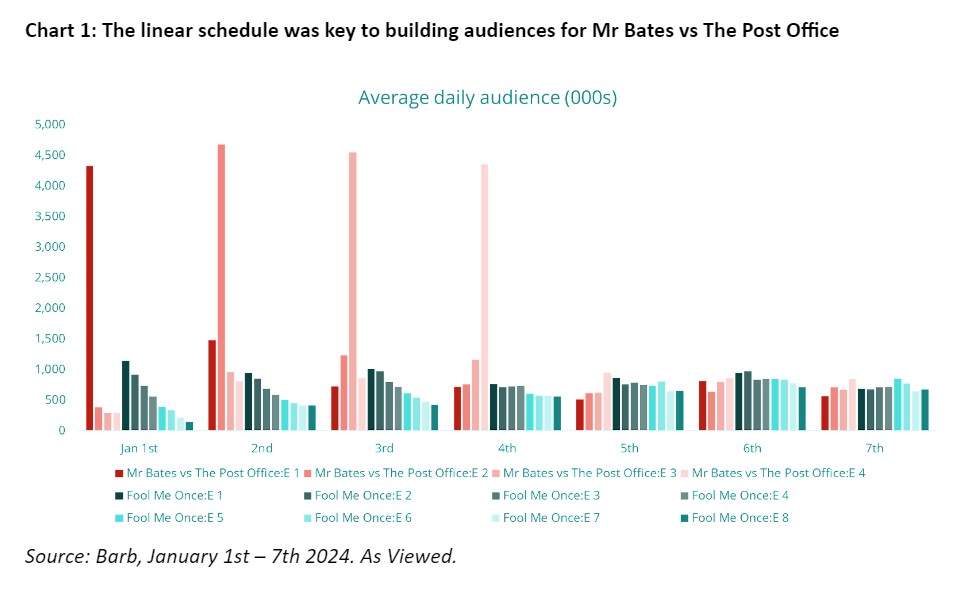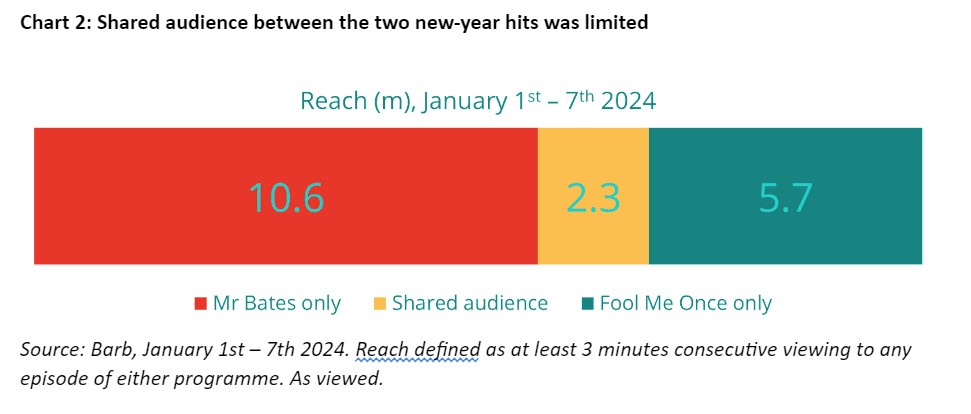Much has been said about the success of ITV’s drama ‘Mr Bates vs The Post Office’, which put the Horizon scandal back at the top of the political agenda. There’s a lot to be learned too from how the show built its audience says Doug Whelpdale, Head of Insight at Barb. In this piece Whelpdale compares the performance of ‘Mr Bates’ with Netflix drama ‘Fool Me Once’, showing how the linear broadcast model helped deliver massive viewing figures for the ITV show.
On New Year’s Day the nation’s largest commercial broadcaster, ITV, and Netflix, the largest pureplay VOD service, gave us two stories of intrigue and deception, one true, the other fictional.
The headline viewing figures have been well publicised. The first episode of ITV’s Mr Bates vs The Post Office won a seven-day audience of 9.2m. On Netflix, Fool Me Once’s first episode achieved 6.3m over the same seven days.
There is a growing body of thought within the industry that, with a few exceptions, on-demand viewing has superseded viewing live at the point of broadcast. So, some may be surprised to see that Mr Bates concentrated its audience build in the first four days. Episodes were broadcast on consecutive days from January 1st to 4th.
Chart 1 shows that the majority of the audience each day was to the episode that was being broadcast. And that this audience was around four times the size of audiences to individual episodes of Fool Me Once.
Audiences to the eight episodes of Fool Me Once, by contrast, were more evenly distributed by day and episode. The caveat is that we are comparing eight episodes of the Netflix programme to four for ITV, but episodes were a similar length.
What the chart highlights (not for the first time) is the importance of the linear broadcast. In Campaign recently, Lauren Ogúndèkó, Chief Digital Officer at Initiative UK said that while recent years have witnessed the “rise of streaming services, linear TV still draws larger and more diverse audiences.”
It might be argued that the first four days of the year are not normal viewing conditions, with audience expectations perhaps higher than normal after the holiday period. But this applies to both equally, and was not the only thing they had in common: both sat in the same genre – crime and legal (albeit one was fictional); were set in the UK; and featured strong British casts. Might we then expect a strong audience overlap?
The chart answers ‘No’. The combined seven-day reach of 18.6m viewers, saw just 2.3m – 12% – watching part of both programmes in that time.
Examining the audience profile of each programme reveals a reason for the limited crossover. While gender and social class breakdowns were similar, the audience to Mr Bates was much older, with 69 percent aged 55+. By contrast, at 35 percent in the 55+ group, the Netflix audience skewed younger.
A lower shared audience means higher potential to ad incremental reach
This limited crossover does have a potential bonus for advertisers. If the shared audience were large there may be little point advertising on both platforms. These data demonstrate that a campaign around these titles that added Netflix to ITV, or vice-versa, could expect to add significant additional reach, as well as a different age-profile audience.
However, we must caveat that we don’t currently split out those viewers on the ad tier of Netflix, so campaign extensions that added Netflix couldn’t count on adding the entire 5.7m audience that only viewed Fool Me Once in this instance.
Both programmes were clearly successes for the channel/service concerned. Both demonstrate the power of television to capture large audiences in a short space of time.
They may have been based on tales of intrigue, misjustice and deception, but Barb’s independent people-based data provides an honest, true and credible view of their audiences.
Doug Whelpdale is Head of Insight at Barb. For more information visit: barb.co.uk







